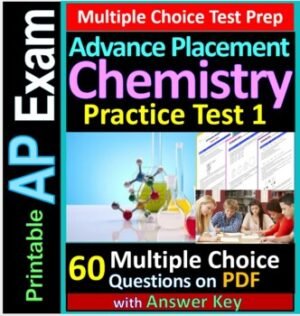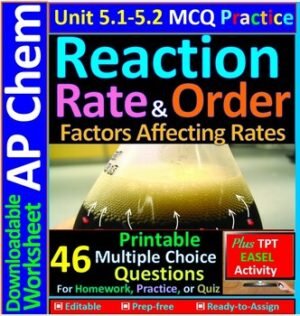Description
This complete and chunking high school chemistry lesson plan includes six essential resources for teaching, assigning work, and assessing your student’s understanding of Types of Aqueous Solutions.
Following the NYS Chemistry curriculum in the Physical Setting, this product includes PPT teaching notes, printable guided readings, engaging worksheets, practice questions, a study guide, exit tickets, and a bellringer. Ready for you to use immediately, or easily add to and supplement your current lesson plan, these resources guarantee a smooth, cohesive, and consistent teaching experience from start to end, reinforcing key concepts effectively, and helping your students learn and understand more.
Please click now to preview examples of each resource and discover why they will enhance your classroom teaching and learning experience.
This lesson is part of my Complete Year Long Chemistry Curriculum, which covers 13 topics and has 61 lessons in total. Consider the Year Long Bundle to Save time and money.
PLEASE NOTE: This is
Lesson 26: Types of Solutions and Reading the Solubility Curves Table
from Topic 7 – Aqueous Solutions
Goals and Objectives of This Lesson:
Vocabulary Terms: After learning this lesson, your students should be able to define or explain these terms:
● Solubility ●Saturated solution ●Supersaturated solution ● Unsaturated solution ●Dilute solution ●Concentrated solution ●Precipitate
Concept Tasks: After learning this lesson, your students should be able to read and use NYS Reference Table G – The Solubility Curves to:
- Determine grams of a solute that will form a saturated solution
- Determine if a solution is saturated, supersaturated, or unsaturated
- Identify the solute that is most or least soluble at a given temperature
- Identify which saturated solution is most or least dilute or concentrated
- Several example problems are given for students to follow
As with all my products, each resource in this product neatly organizes concepts, ideas, vocabulary terms, example problems, and skill tasks into manageable chunk sets. This makes teaching easier for educators and helps students focus on learning one thing at a time.
Benefits of Chunking for Teachers:
- Improved lesson planning
- Clear presentation
- Reduced confusion
- More engaged students
- Efficient time management
- Adaptability to different learning styles
- Helpful for assessing student understanding and progress
Benefits of Chunking for Students:
- Minimize information overload
- Improved focus
- Better memory retention and recall
- Easier understanding and connecting of ideas
- Encouragement for active learning
- Building confidence
Answer keys for all questions are included when needed, and permission for TPT Easel Activity is given for creating online assignments.
Note: This product is similar to the Hybrid Bundle Lesson Plan but does not include the Google Form Online Worksheet, making it a more affordable option for those not using Google Form assignments.
Remember to follow my TPT store and check out my new Chunking Science Blog Site (Launching March 2024) for freebies, teaching ideas, and exam prep tips. Thank you!









Reviews
There are no reviews yet.